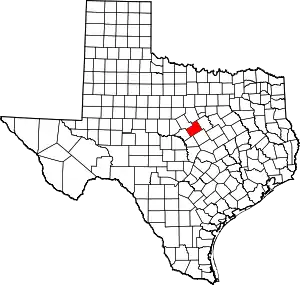For other instances of Hico, see: Hico (disambiguation)
Hico, Texas | |
|---|---|
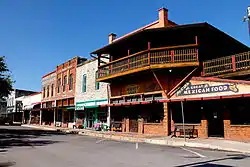 Hico | |
| Motto: "Where Everybody Is Somebody"
 Downtown Hico, Texas Wagon Team. c. 1910 | |
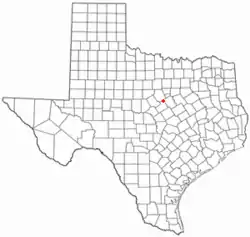 Location of Hico, Texas | |
 | |
| Coordinates: 31°59′4″N 98°1′50″W / 31.98444°N 98.03056°W | |
| Country | United States |
| State | Texas |
| Counties | Hamilton |
| Area | |
| • Total | 1.82 sq mi (4.73 km2) |
| • Land | 1.82 sq mi (4.72 km2) |
| • Water | 0.00 sq mi (0.00 km2) |
| Elevation | 1,027 ft (313 m) |
| Population (2020) | |
| • Total | 2,611 |
| • Estimate (2019)[2] | 1,413 |
| • Density | 774.67/sq mi (299.13/km2) |
| Time zone | UTC-6 (Central (CST)) |
| • Summer (DST) | UTC-5 (CDT) |
| ZIP code | 76457 |
| Area code | 254 |
| FIPS code | 48-33548[3] |
| GNIS feature ID | 1374058[4] |
| Website | hico-tx |
Hico (/ˈhaɪkoʊ/, HY-koh) is a small city located in Hamilton County in central Texas, United States.[5] The population was 2,611 at the time of the 2020 census, up from 1,379 in the 2010 census.
Named for its founder's hometown of Hico in southwestern Kentucky, Hico's original location was on Honey Creek. When the Texas Central line (part of the historic Katy Railroad) was built nearby, the citizens moved 2.5 miles (4.0 km) to the rail line. Hico was incorporated in 1883 and became the Hamilton County shipping center. Over the years, it became a cattle and cotton market. Today, ranching and tourism dominate the local economy.[6]
In 1903, Kentucky-based evangelist Mordecai Ham held the first of his 75 Texas revival meetings in Hico. There were 150 professions of faith in Jesus Christ.[7]
"Brushy Bill" Roberts and Billy the Kid
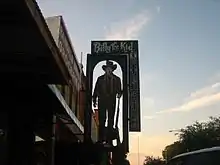

Roberts' grave has not been revealed, thus preventing DNA authentication of the remains.[8]
The Hico community
Hico hosts the Annual Texas Steak Cookoff in May. It boasts thousands of guests every year.
Geography
Hico is located in the northern corner of Hamilton County at 31°59′4″N 98°1′50″W / 31.98444°N 98.03056°W (31.984410, –98.030508).[9] A small portion of the city extends north into Erath County. U.S. Route 281 passes through the city as Walnut Street and North 2nd Street. Highway 281 leads northwest 19 miles (31 km) to Stephenville and south 20 miles (32 km) to Hamilton, the county seat. Texas State Highway 6 passes through the city as Second Street, joining US 281 as it exits the city to the northwest. Highway 6 leads east 23 miles (37 km) to Meridian and west-northwest 21 miles (34 km) to Dublin.
According to the United States Census Bureau, Hico has a total area of 1.8 square miles (4.7 km2), all land.[5]
Approximately 1.8 miles (2.9 km) north of Hico are what appear to be the remains of an impact crater that was formed some time after the Cretaceous Period.[10]
Demographics
| Census | Pop. | Note | %± |
|---|---|---|---|
| 1890 | 649 | — | |
| 1900 | 1,480 | 128.0% | |
| 1910 | 1,427 | −3.6% | |
| 1920 | 1,635 | 14.6% | |
| 1930 | 1,463 | −10.5% | |
| 1940 | 1,242 | −15.1% | |
| 1950 | 1,212 | −2.4% | |
| 1960 | 1,020 | −15.8% | |
| 1970 | 925 | −9.3% | |
| 1980 | 1,375 | 48.6% | |
| 1990 | 1,342 | −2.4% | |
| 2000 | 1,341 | −0.1% | |
| 2010 | 1,379 | 2.8% | |
| 2019 (est.) | 1,413 | [2] | 2.5% |
| U.S. Decennial Census[11] | |||
2020 census
| Race | Number | Percentage |
|---|---|---|
| White (NH) | 1,038 | 77.75% |
| Black or African American (NH) | 5 | 0.37% |
| Native American or Alaska Native (NH) | 8 | 0.6% |
| Asian (NH) | 8 | 0.6% |
| Pacific Islander (NH) | 1 | 0.07% |
| Some Other Race (NH) | 1 | 0.07% |
| Mixed/Multi-Racial (NH) | 55 | 4.12% |
| Hispanic or Latino | 219 | 16.4% |
| Total | 1,335 |
As of the 2020 United States census, there were 1,335 people, 619 households, and 269 families residing in the city.
2000 census
As of the census[3] of 2000, there were 1,341 people, 556 households, and 363 families residing in the city. The population density was 911.4 inhabitants per square mile (351.9/km2). There were 640 housing units at an average density of 435.0 per square mile (168.0/km2). The racial makeup of the city was 90.23% White, 0.82% Native American, 0.15% Pacific Islander, 7.53% from other races, and 1.27% from two or more races. Hispanic or Latino of any race were 11.26% of the population.
There were 556 households, out of which 30.8% had children under the age of 18 living with them, 51.4% were married couples living together, 10.6% had a female householder with no husband present, and 34.7% were non-families. 31.5% of all households were made up of individuals, and 22.3% had someone living alone who was 65 years of age or older. The average household size was 2.37 and the average family size was 2.99.
In the city, the population was spread out, with 26.2% under the age of 18, 6.9% from 18 to 24, 23.8% from 25 to 44, 20.5% from 45 to 64, and 22.6% who were 65 years of age or older. The median age was 40 years. For every 100 females, there were 82.9 males. For every 100 females age 18 and over, there were 77.9 males.
The median income for a household in the city was $25,919, and the median income for a family was $34,688. Males had a median income of $27,404 versus $17,708 for females. The per capita income for the city was $14,122. About 13.6% of families and 19.5% of the population were below the poverty line, including 27.2% of those under age 18 and 22.4% of those age 65 or over.
Education
The city is served by the Hico Independent School District, home of the Hico Tigers and Lady Tigers.
Climate
The climate in this area is characterized by hot, humid summers and generally mild to cool winters. According to the Köppen Climate Classification system, Hico has a humid subtropical climate, abbreviated "Cfa" on climate maps.[15]
Notable people
- Mary Charlotte Ward Granniss Webster Billings, Texas' first woman Universalist minister. She resided here for many years and died in 1904
- Major General William F. Garrison (Ret.), Best known for being the commander of Task Force Ranger during Operation Gothic Serpent in Mogadishu, Somalia in 1993, resides at his ranch near Hico with his family
- Brushy Bill Roberts 1879–1950 - claimed to be Billy The Kid
- Mattie Parker, mayor of Fort Worth, Texas (2021–present) was born and raised in Hico
Hico gallery
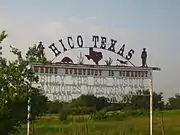 Hico, Texas: "Where Everybody Is Somebody"
Hico, Texas: "Where Everybody Is Somebody"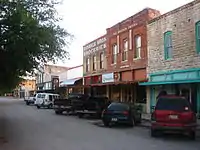 Historic district in Hico
Historic district in Hico Koffee Kup Restaurant in Hico
Koffee Kup Restaurant in Hico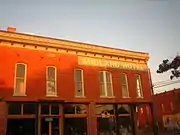 The Midland Hotel of Hico, Texas
The Midland Hotel of Hico, Texas Office of Hico News Review (founded 1895)
Office of Hico News Review (founded 1895) First Baptist Church of Hico on U.S. Highway 281 South
First Baptist Church of Hico on U.S. Highway 281 South First United Methodist Church in Hico
First United Methodist Church in Hico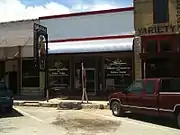 Billy the Kid Museum
Billy the Kid Museum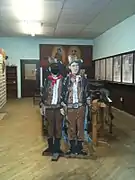 Photo-op mockup of Billy the Kid in the Chamber of Commerce
Photo-op mockup of Billy the Kid in the Chamber of Commerce.jpg.webp) Trippet-McCarty House
Trippet-McCarty House.jpg.webp) Wiseman House
Wiseman House.jpg.webp) Old Hico School
Old Hico School.jpg.webp) 1895 Opera House
1895 Opera House.jpg.webp) Log Cabin
Log Cabin.jpg.webp) City Hall
City Hall.jpg.webp) Barbershop
Barbershop.jpg.webp) C.L. Lynch Building
C.L. Lynch Building.jpg.webp) Wiseman Chocolates and an old drug store building
Wiseman Chocolates and an old drug store building.jpg.webp) Old building in Hico
Old building in Hico.jpg.webp) Downtown Hico
Downtown Hico.jpg.webp) Midland Hotel
Midland Hotel.jpg.webp) Connolly Building
Connolly Building.jpg.webp) Billy the Kid Museum
Billy the Kid Museum.jpg.webp) Old building in Hico
Old building in Hico.jpg.webp) Billy the Kid statue
Billy the Kid statue
6.See also
References
- ↑ "2019 U.S. Gazetteer Files". United States Census Bureau. Retrieved August 7, 2020.
- 1 2 "Population and Housing Unit Estimates". United States Census Bureau. May 24, 2020. Retrieved May 27, 2020.
- 1 2 "U.S. Census website". United States Census Bureau. Retrieved January 31, 2008.
- ↑ "US Board on Geographic Names". United States Geological Survey. October 25, 2007. Retrieved January 31, 2008.
- 1 2 "Geographic Identifiers: 2010 Census Summary File 1 (G001): Hico city, Texas". American Factfinder. U.S. Census Bureau. Archived from the original on February 13, 2020. Retrieved February 2, 2018.
- ↑ Texas Department of Transportation, Texas State Travel Guide, 2008, pp. 200-201
- ↑ Jerry Hopkins of East Texas Baptist University, "Evangelist Mordecai F. Ham's West Texas Meetings, 1903-1940", paper at East Texas Historical Association and West Texas Historical Association joint meeting in Fort Worth, Texas, February 26, 2010
- ↑ Hico News Review, September 28, 1996
- ↑ "US Gazetteer files: 2010, 2000, and 1990". United States Census Bureau. February 12, 2011. Retrieved April 23, 2011.
- ↑ Potential of Radar Imaging and Sounding Methods in Mapping Heavily Eroded Impact Craters: Mapping Some Structural Elements of the Hico Crater, TX (PDF), Lunar and Planetary Science XXXV (2004). Retrieved 2008-05-28
- ↑ "Census of Population and Housing". Census.gov. Retrieved June 4, 2015.
- ↑ "Explore Census Data". data.census.gov. Retrieved May 21, 2022.
- ↑ https://www.census.gov/
- ↑ "About the Hispanic Population and its Origin". www.census.gov. Retrieved May 18, 2022.
- ↑ "Hico, Texas Köppen Climate Classification (Weatherbase)". Retrieved August 1, 2016.
